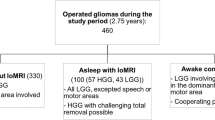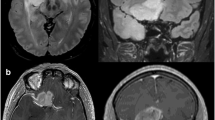Abstract
Background
Complete resection of grade II gliomas might prolong survival but is not always possible. The goal of the study was to evaluate the location of unexpected grade II gliomas remnants after assumed complete removal with intraoperative (iop) MRI and to assess the reason for their non-detection.
Methods
Intraoperative MR images of 35 patients with hemispheric grade II gliomas, acquired after assumed complete removal of preoperatively segmented tumor/tumor part, were studied for existence of unexpected tumor remnants. Remnants location was classified in relation to tumor cavity in axial and vertical planes. The relation of remnants to retractor position and to surgeons’ visual axis, and the role of neuronavigational accuracy and brain shift, was assessed.
Results
Unexpected remnants were found in 16 patients (46%). In 29.2%, the reason was loss of neuronavigational accuracy. In 21%, remnants were in that part of the resection cavity, where the retractor had been placed initially. In 17%, they were deeply located and hidden by the retractor. In 13%, remnants were hidden by the overlapping brain; and in 21%, the reason was not obvious. In 75% of all temporomesial tumors, remnants were posterolateral to the resection cavity. Remnants detection with iopMRI and update of neuronavigational data allowed further removal in 14 of 16 cases. In two cases, remnant location precluded their removal.
Conclusions
Distribution of tumor remnants of grade II gliomas tends to follow some patterns. Targeted attention to the areas of possible remnants could increase the radicality of surgery, even if intraoperative imaging is not performed.





Similar content being viewed by others
References
(1998) Practice parameters in adults with suspected or known supratentorial nonoptic pathway low-grade glioma. Neurosurg Focus 4:e10
Bauman G, Fisher B, Watling C, Cairncross JG, Macdonald D (2009) Adult supratentorial low-grade glioma: long-term experience at a single institution. Int J Radiat Oncol Biol Phys 75:1401–1407
Berger MS, Deliganis AV, Dobbins J, Keles GE (1994) The effect of extent of resection on recurrence in patients with low grade cerebral hemisphere gliomas. Cancer 74:1784–1791
Berger MS, Hadjipanayis CG (2007) Surgery of intrinsic cerebral tumors. Neurosurgery 61:279–304, discussion 304–275
Berger MS, Rostomily RC (1997) Low grade gliomas: functional mapping resection strategies, extent of resection, and outcome. J Neurooncol 34:85–101
Black PM, Alexander E 3rd, Martin C, Moriarty T, Nabavi A, Wong TZ, Schwartz RB, Jolesz F (1999) Craniotomy for tumor treatment in an intraoperative magnetic resonance imaging unit. Neurosurgery 45:423–431, discussion 431–423
Bradley WG (2002) Achieving gross total resection of brain tumors: intraoperative MR imaging can make a big difference. AJNR Am J Neuroradiol 23:348–349
Cavaliere R, Lopes MB, Schiff D (2005) Low-grade gliomas: an update on pathology and therapy. Lancet Neurol 4:760–770
Claus EB, Horlacher A, Hsu L, Schwartz RB, Dello-Iacono D, Talos F, Jolesz FA, Black PM (2005) Survival rates in patients with low-grade glioma after intraoperative magnetic resonance image guidance. Cancer 103:1227–1233
Duffau H, Lopes M, Arthuis F, Bitar A, Sichez JP, Van Effenterre R, Capelle L (2005) Contribution of intraoperative electrical stimulations in surgery of low grade gliomas: a comparative study between two series without (1985–96) and with (1996–2003) functional mapping in the same institution. J Neurol Neurosurg Psychiatry 76:845–851
Fahlbusch R, Samii A (2007) A review of cranial imaging techniques: potential and limitations. Clin Neurosurg 54:100–104
Ganser KA, Dickhaus H, Staubert A, Bonsanto MM, Wirtz CR, Tronnier VM, Kunze S (1997) Quantification of brain shift effects in MRI images. Biomed Tech 42:247–248
Gerganov VM, Samii A, Akbarian A, Stieglitz L, Samii M, Fahlbusch R (2009) Reliability of intraoperative high-resolution 2D ultrasound as an alternative to high-field strength MR imaging for tumor resection control: a prospective comparative study. J Neurosurg 111:512–519
Hatiboglu MA, Weinberg JS, Suki D, Rao G, Prabhu SS, Shah K, Jackson E, Sawaya R (2009) Impact of intraoperative high-field magnetic resonance imaging guidance on glioma surgery: a prospective volumetric analysis. Neurosurgery 64:1073–1081, discussion 1081
Karim AB, Maat B, Hatlevoll R, Menten J, Rutten EH, Thomas DG, Mascarenhas F, Horiot JC, Parvinen LM, van Reijn M, Jager JJ, Fabrini MG, van Alphen AM, Hamers HP, Gaspar L, Noordman E, Pierart M, van Glabbeke M (1996) A randomized trial on dose-response in radiation therapy of low-grade cerebral glioma: European organization for research and treatment of cancer (EORTC) study 22844. Int J Radiat Oncol Biol Phys 36:549–556
Keles GE, Lamborn KR, Berger MS (2001) Low-grade hemispheric gliomas in adults: a critical review of extent of resection as a factor influencing outcome. J Neurosurg 95:735–745
Mandonnet E, Jbabdi S, Taillandier L, Galanaud D, Benali H, Capelle L, Duffau H (2007) Preoperative estimation of residual volume for WHO grade II glioma resected with intraoperative functional mapping. Neuro Oncology 9:63–69
Maurer M, Becker G, Wagner R, Woydt M, Hofmann E, Puls I, Lindner A, Krone A (2000) Early postoperative transcranial sonography (TCS), CT, and MRI after resection of high grade glioma: evaluation of residual tumour and its influence on prognosis. Acta Neurochir (Wien) 142:1089–1097
McGirt MJ, Chaichana KL, Attenello FJ, Weingart JD, Than K, Burger PC, Olivi A, Brem H, Quinones-Hinojosa A (2008) Extent of surgical resection is independently associated with survival in patients with hemispheric infiltrating low-grade gliomas. Neurosurgery 63:700–707, author reply 707–708
Nimsky C, Fujita A, Ganslandt O, Von Keller B, Fahlbusch R (2004) Volumetric assessment of glioma removal by intraoperative high-field magnetic resonance imaging. Neurosurgery 55:discussion 370–351–370
Nimsky C, Ganslandt O, Buchfelder M, Fahlbusch R (2003) Glioma surgery evaluated by intraoperative low-field magnetic resonance imaging. Acta Neurochir Suppl 85:55–63
Nimsky C, Ganslandt O, Buchfelder M, Fahlbusch R (2006) Intraoperative visualization for resection of gliomas: the role of functional neuronavigation and intraoperative 1.5 T MRI. Neurol Res 28:482–487
Nimsky C, Ganslandt O, Cerny S, Hastreiter P, Greiner G, Fahlbusch R (2000) Quantification of, visualization of, and compensation for brain shift using intraoperative magnetic resonance imaging. Neurosurgery 47:1070–1079, discussion 1079–1080
Philippon JH, Clemenceau SH, Fauchon FH, Foncin JF (1993) Supratentorial low-grade astrocytomas in adults. Neurosurgery 32:554–559
Pouratian N, Asthagiri A, Jagannathan J, Shaffrey ME, Schiff D (2007) Surgery Insight: the role of surgery in the management of low-grade gliomas. Nat Clin Pract Neurol 3:628–639
Sanai N, Berger MS (2008) Glioma extent of resection and its impact on patient outcome. Neurosurgery 62:753–764, discussion 264–756
Shaw EG, Berkey B, Coons SW, Bullard D, Brachman D, Buckner JC, Stelzer KJ, Barger GR, Brown PD, Gilbert MR, Mehta M (2008) Recurrence following neurosurgeon-determined gross-total resection of adult supratentorial low-grade glioma: results of a prospective clinical trial. J Neurosurg 109:835–841
Smith JS, Chang EF, Lamborn KR, Chang SM, Prados MD, Cha S, Tihan T, Vandenberg S, McDermott MW, Berger MS (2008) Role of extent of resection in the long-term outcome of low-grade hemispheric gliomas. J Clin Oncol 26:1338–1345
Soffietti R, Chio A, Giordana MT, Vasario E, Schiffer D (1989) Prognostic factors in well-differentiated cerebral astrocytomas in the adult. Neurosurgery 24:686–692
Stummer W, Pichlmeier U, Meinel T, Wiestler OD, Zanella F, Reulen HJ (2006) Fluorescence-guided surgery with 5-aminolevulinic acid for resection of malignant glioma: a randomised controlled multicentre phase III trial. Lancet Oncol 7:392–401
Talos IF, Zou KH, Ohno-Machado L, Bhagwat JG, Kikinis R, Black PM, Jolesz FA (2006) Supratentorial low-grade glioma resectability: statistical predictive analysis based on anatomic MR features and tumor characteristics. Radiology 239:506–513
Uhl E, Zausinger S, Morhard D, Heigl T, Scheder B, Rachinger W, Schichor C, Tonn JC (2009) Intraoperative computed tomography with integrated navigation system in a multidisciplinary operating suite. Neurosurgery 64:231–239, discussion 239–240
Unsgaard G, Rygh OM, Selbekk T, Muller TB, Kolstad F, Lindseth F, Hernes TA (2006) Intra-operative 3D ultrasound in neurosurgery. Acta Neurochir 148:235–253, discussion 253
Unsgaard G, Selbekk T, Brostrup Muller T, Ommedal S, Torp SH, Myhr G, Bang J, Nagelhus Hernes TA (2005) Ability of navigated 3D ultrasound to delineate gliomas and metastases—comparison of image interpretations with histopathology. Acta Neurochir (Wien) 147:discussion 1269–1269
Acknowledgment
Disclosure
Parts of this study have been presented at the DGNC meeting in Münster, May 25–27, 2009.
Conflicts of interest
None.
Author information
Authors and Affiliations
Corresponding author
Rights and permissions
About this article
Cite this article
Gerganov, V.M., Samii, A., Stieglitz, L. et al. Typical 3-D localization of tumor remnants of WHO grade II hemispheric gliomas—lessons learned from the use of intraoperative high-field MRI control. Acta Neurochir 153, 479–487 (2011). https://doi.org/10.1007/s00701-010-0911-3
Received:
Accepted:
Published:
Issue Date:
DOI: https://doi.org/10.1007/s00701-010-0911-3




